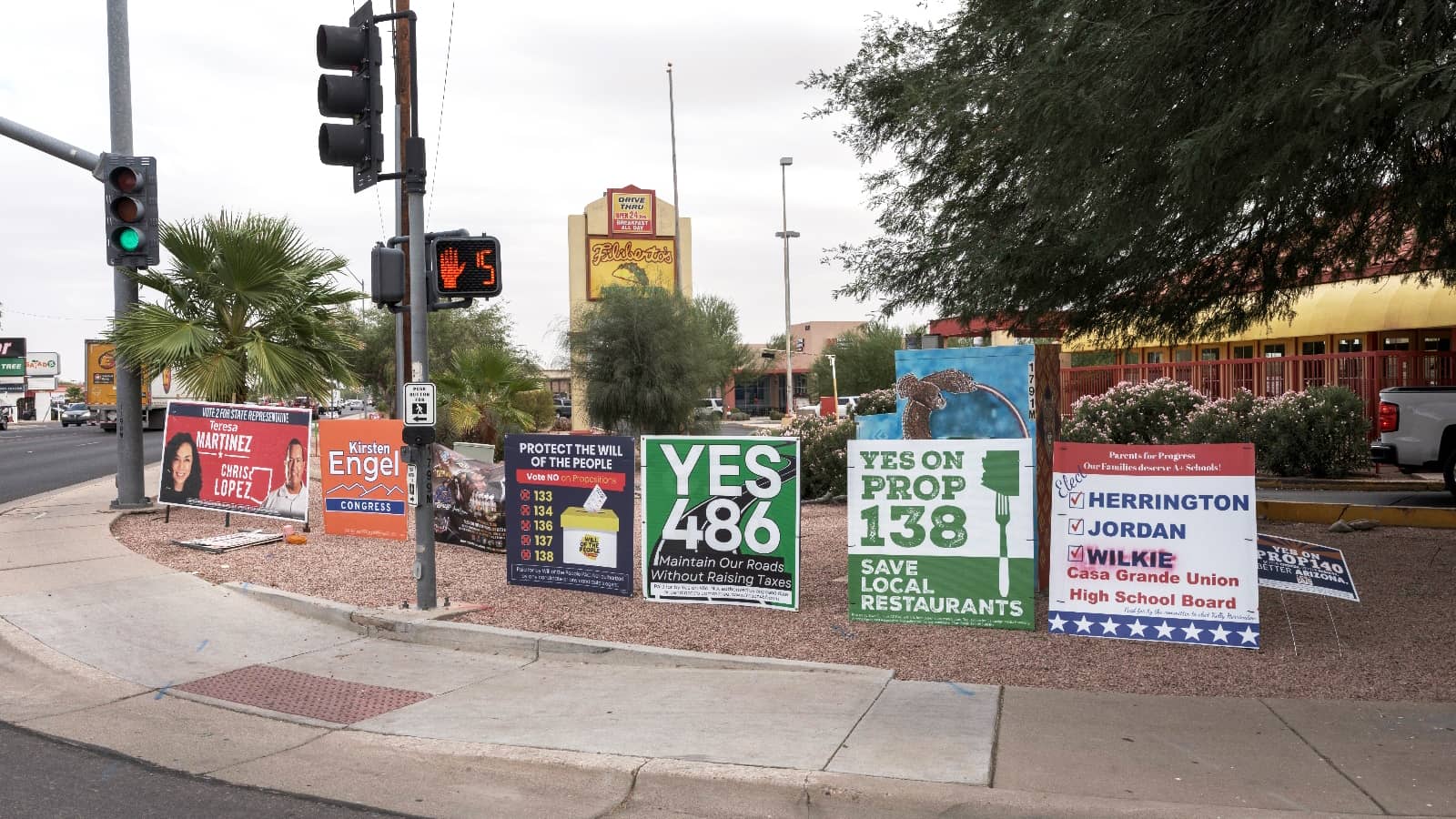Hello, and welcome back to State of Emergency. I’m Jake Bittle, and today we’re going to shift the focus away from the storm-battered Southeast and take a look at one of the nation’s hottest battleground states.
Election Day is just two weeks away, and the high-octane race for president is consuming almost all the media’s attention — we’ll have a big package up on Grist tomorrow on the stakes of the election for all facets of the climate fight. Perhaps nowhere is the election intensity higher than in Arizona, a border state that has seen sky-high rates of inflation and a bruising debate over a restrictive abortion ban. Not only is the state a linchpin for the Electoral College, it’s also the site of toss-up races for the Senate and the House of Representatives. There’s also a pivotal contest for the state legislature, where Republicans hold one-seat majorities in both chambers.
Political signs ring a street corner in Casa Grande, Arizona, in the run-up to Election Day.
Eliseu Cavalcante / Grist
I visited the Grand Canyon State during an unseasonably hot week in early October, when temperatures were still cresting into the triple digits every afternoon. I found that the frenzy of national politics has pulled attention away from the issue that is perhaps most important to Arizona’s future: water. Thanks to a millennium-scale drought fueled by climate change, the state has lost a huge share of the water it gets from the all-important Colorado River, and groundwater aquifers are falling in rural farm areas as well as in big cities like Phoenix.
This fall’s election will determine how the state tackles this crisis. If Democrats take control of the legislature, they’ll impose strict rules on water usage by farms and developers, which they hope will ease the state’s water shortage even if it raises costs for the agriculture and real estate industries. Republicans will opt for easier rules, or no new rules at all, which many experts fear could lead to more wells going dry in suburbs and rural areas near big farms.
Water is an invisible issue until the moment your tap stops working.
The outcome of the race depends on just a few swing districts, most of them suburban areas around bigger cities like Phoenix and Tucson, but you might not know from visiting these places that water is on the ballot in November. That’s because the state’s water policy is a complex tangle of acronyms and agencies, and in part because water is an invisible issue until the moment your tap stops working. Wells have gone dry already in ruby-red rural areas around the state, but for the suburban voters who will decide control of the legislature, this kind of water crisis is still decades away. They’ll go to the polls to make their voices heard on abortion, education, and the economy — but the ballots they cast could have huge implications for the dwindling aquifers under their feet.
You can read my full report from Arizona’s scorching swing districts here.
The big challenges facing the smallest state capital in the country

Ben Doyle, a volunteer on the Montpelier Planning and Resilience Commission, shows how high the floodwater got in Montpelier, Vermont.
Zoya Teirstein / Grist
In response to a question about her plan to address climate change on the debate stage this summer, Vice President and presidential hopeful Kamala Harris didn’t talk about renewable energy, greenhouse gas emissions, or clean energy jobs — talking points President Joe Biden has often leaned on. She talked about housing. Climate change, she said, is happening: “You ask anybody who has been the victim of what that means in terms of losing their home, having nowhere to go.”
America’s housing crisis is one of the only issues Republicans and Democrats in Congress agree needs to be fixed, and fast. The problem dates back to 2008, when the Great Recession caused real estate developers to cut back dramatically on the number of homes they were building. The rate of new homes for sale has lagged ever since, adding up to a deficit of 3.8 million housing units across the country as of 2020.
“We thought we were in this climate change haven, then you realize that that doesn’t really exist.”
— A resident who moved to Vermont from California
Now, extreme weather events are squeezing already-limited housing options: 2.5 million Americans were displaced, either temporarily or permanently, by extreme weather last year. It’s likely that even more have been displaced by this year’s hurricanes. So what can states do about this problem? I traveled to Vermont’s tiny state capital last month to talk to people there about the most common, and most expensive, climate-driven threat in the U.S.: flooding.
Last year, more than 12 inches of rain fell on Montpelier in the span of a few days, breaking a rainfall record set in 1989. “We thought we were in this climate change haven,” one resident who moved to Vermont from California told me, “then you realize that that doesn’t really exist.”
In Montpelier, city leaders, nonprofits, business associations, and tourism boards are trying to take on the city’s twin housing and climate crises. Working alongside the city council, the coalition is racing against the clock to make Montpelier more resilient before its next collision with climate change. “Our federal, our state, and our local government all need to be better equipped to help people through these challenging climate disasters that we know are just going to continue growing,” a member of the Montpelier City Council told me. “We need to do better.” You can read my full story here.
— Zoya Teirstein
What we’re reading
An update on voting in North Carolina: The Guardian examines how candidates in western North Carolina — from those running for the smallest local positions to the presidential nominees — are struggling to reach voters in the wake of Hurricane Helene and a disaster that won’t be resolved for months or even years. Read more
Read more
Who helps tribes after disaster strikes? Our colleague Taylar Dawn Stagner, on Grist’s Indigenous Affairs desk, has the story on why Indigenous peoples in the U.S. are routinely left out of federal disaster relief and how tribes are stepping into the void to help other tribes recover from Hurricane Helene. Read more
Read more
Chris Christie on the politicization of hurricanes: The New York Times opinion columnist Frank Bruni talked to former New Jersey Governor Chris Christie about hurricanes Helene and Milton, lessons learned from Superstorm Sandy recovery, and why he hugged former President Barack Obama in 2012, scandalizing the GOP at the time (and still to this day, Christie says). Read more
Read more
What’s FEMA funding being used for? The Arizona Republic fact checked viral claims that Federal Emergency Management Administration funds are being used to house illegal immigrants. FEMA does have a Shelter and Services program that helps states house and organize an influx of immigrants, in partnership with the U.S. Customs and Border Patrol. But the money for that program and FEMA funding for hurricane relief and recovery come from two entirely separate pots. Read more
Read more
What happened to the progressive left? Four years ago, Democratic candidates for president were unveiling multi-trillion-dollar climate plans, among other progressive policies. Now, VP Kamala Harris — who wielded a $10 trillion climate plan during her 2019 run for the White House — has no climate platform to speak of. She appears to be more focused on convincing swing voters that she won’t ban fracking. Vox’s senior political correspondent Andrew Prokop took a broad look at why Democrats have moved to the right over the past four years. Read more
Read more

